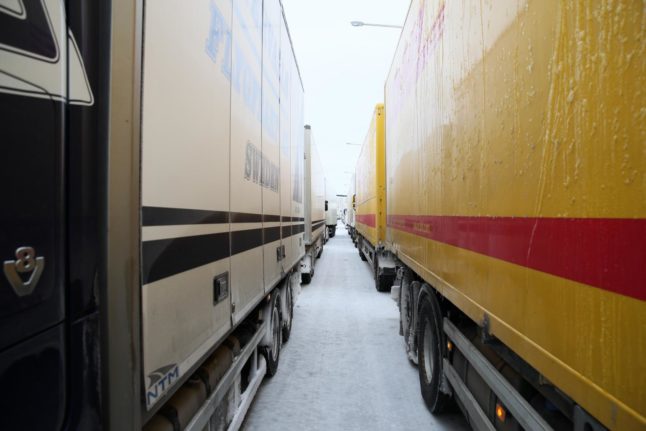National road 47 between Trollhättan and Oskarshamn
At lunchtime on Wednesday, hundreds of cars were still at a standstill on national road 47 in Västra Götaland, with around 200 lorries stranded on Wednesday morning.
In addition to this, some cars were driving in the wrong direction, according to public broadcaster SVT.
“A number of people have decided to drive around [the traffic jam] despite the road conditions and our recommendations. We’ve heard that people have turned around and driven in the wrong direction,” police press spokesperson August Brandt told SVT.
E4 and E20 motorways and national road 26
Transport Administration press officer Bengt Olsson has warned drivers to avoid the E4 northbound at Jönköping, as well as the E20 motorway and national road 26.
“We still have long-distance trucks stuck at the side of the road, which means it can be tight to get past. If you can avoid driving there I think you should do so,” he told SVT.
All of the cars that were stuck on the E4 between Huskvarna and Gränna overnight had been able to continue their journeys as of 9am this morning, Jönköping municipality said in a press statement, although drivers are still encouraged to avoid the road due to ongoing snow removal, and cars are being diverted via Eksjö.
“Road conditions are still difficult and we encourage everyone who can avoid driving to do so. The Transport Administration and the technical office are going to have to shovel the roads,” vice head of Jönköping rescue services Göran Melin told TT newswire.
There are also traffic jams on the E4 between Torsvik and the Asecs shopping centre in Jönköping northbound, as well as on the 933 road between Huskvarna and Gränna.
The E20 outside Mariefred in Sörmland was also at a standstill on Wednesday just before noon after an accident by the Läggesta services, P4 Sörmland reports.
The Öland Bridge
The bridge linking the island of Öland with the mainland was closed on Wednesday morning but has now reopened, although there’s a risk it could be closed again if winds pick up.
“If there are strong gusts of wind on the Öland Bridge there’s a risk that tall or heavily loaded vehicles could get blown away,” Olsson told SVT.
Road 55 north of Norrköping
In Östergötland there is snow and black ice on many roads, including road 55, which was at a standstill northbound on Wednesday morning due to a lorry driving into the barrier in the central reservation and blocking traffic, SVT reports. The road was still closed at noon on Wednesday and is expected to open again this afternoon.
If you’re planning to head out on the Swedish roads this afternoon, make sure to check your planned route via the Transport Administration’s website.



 Please whitelist us to continue reading.
Please whitelist us to continue reading.
Member comments